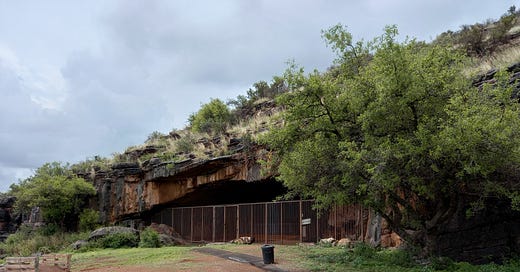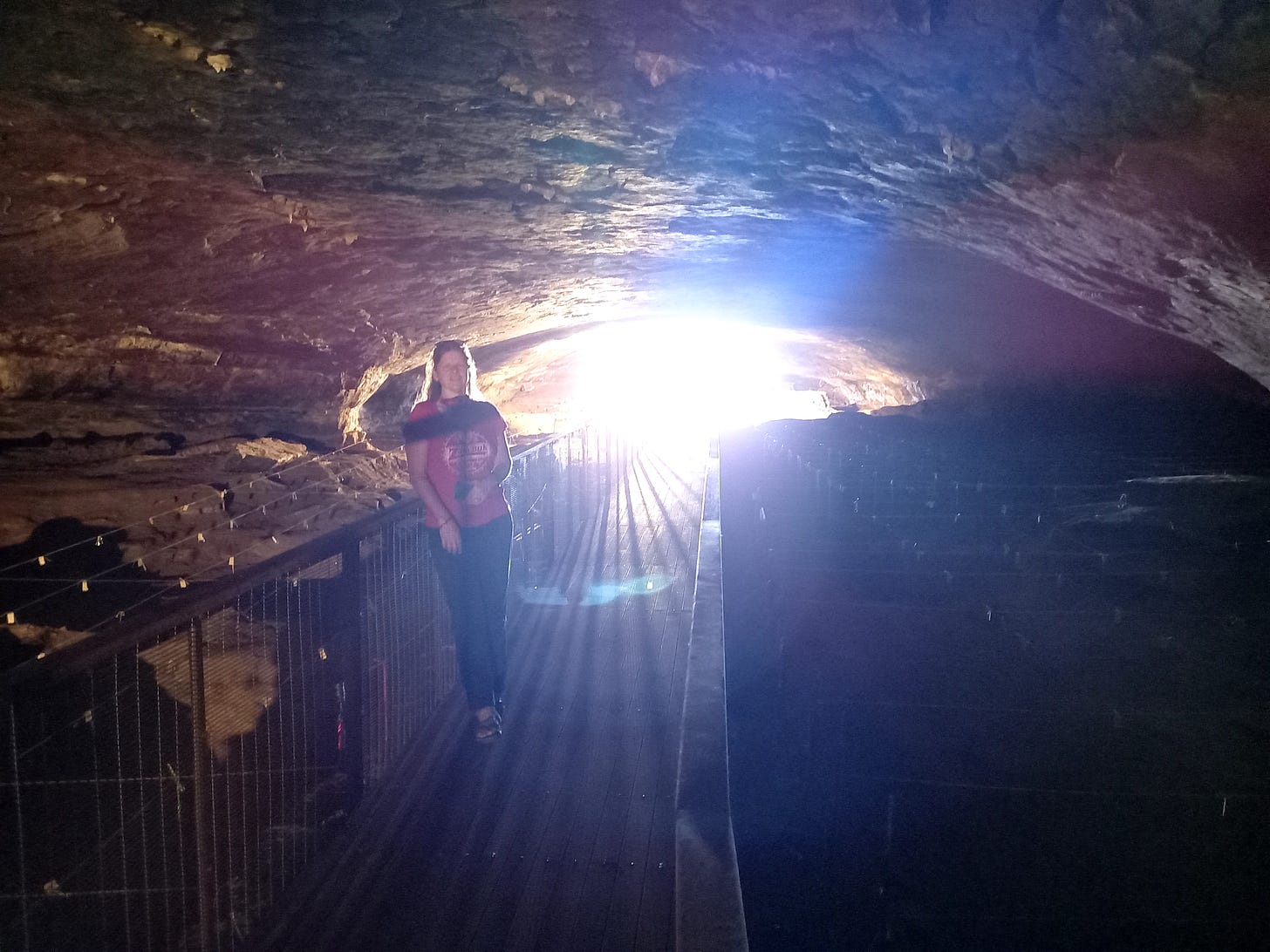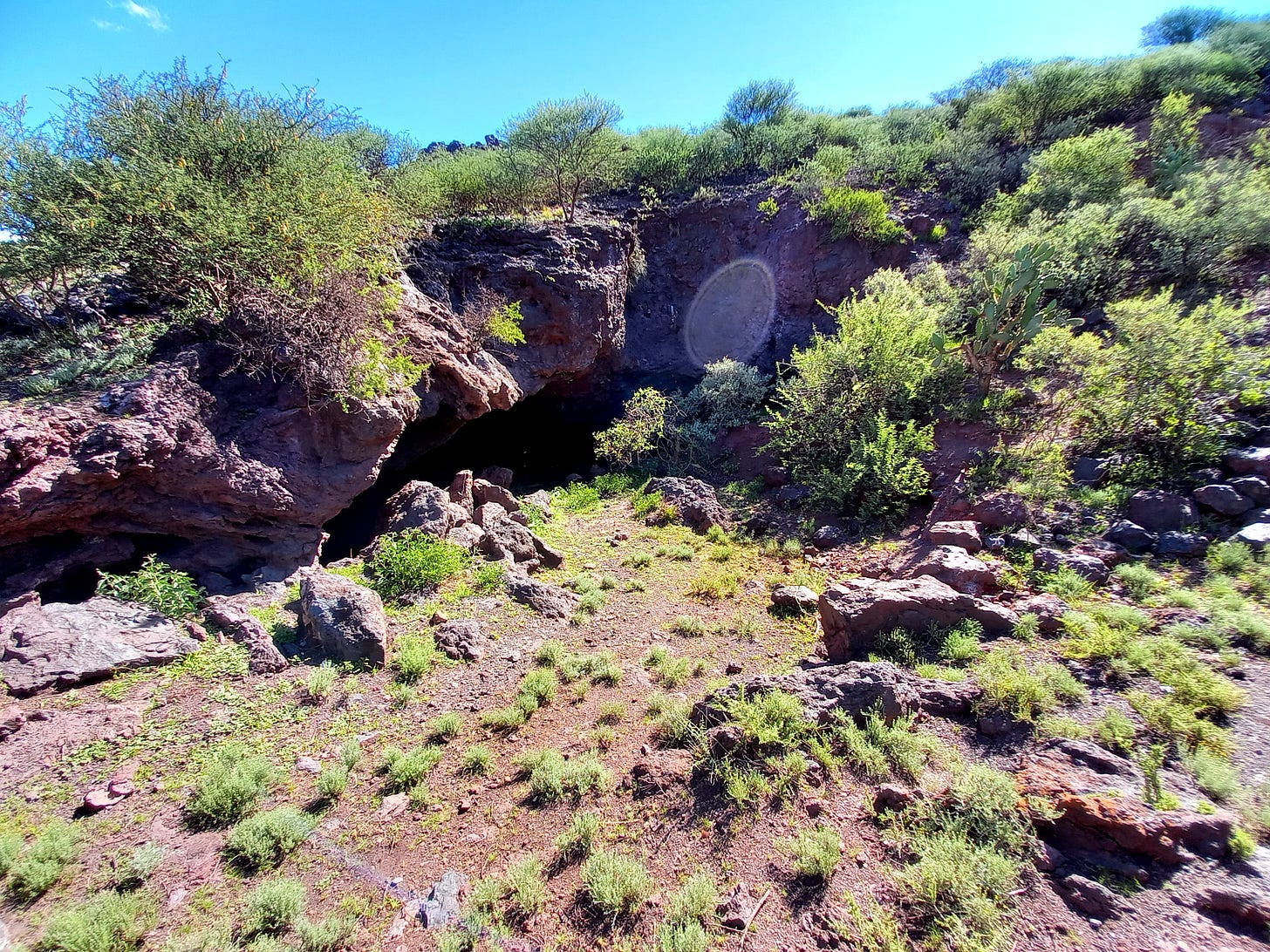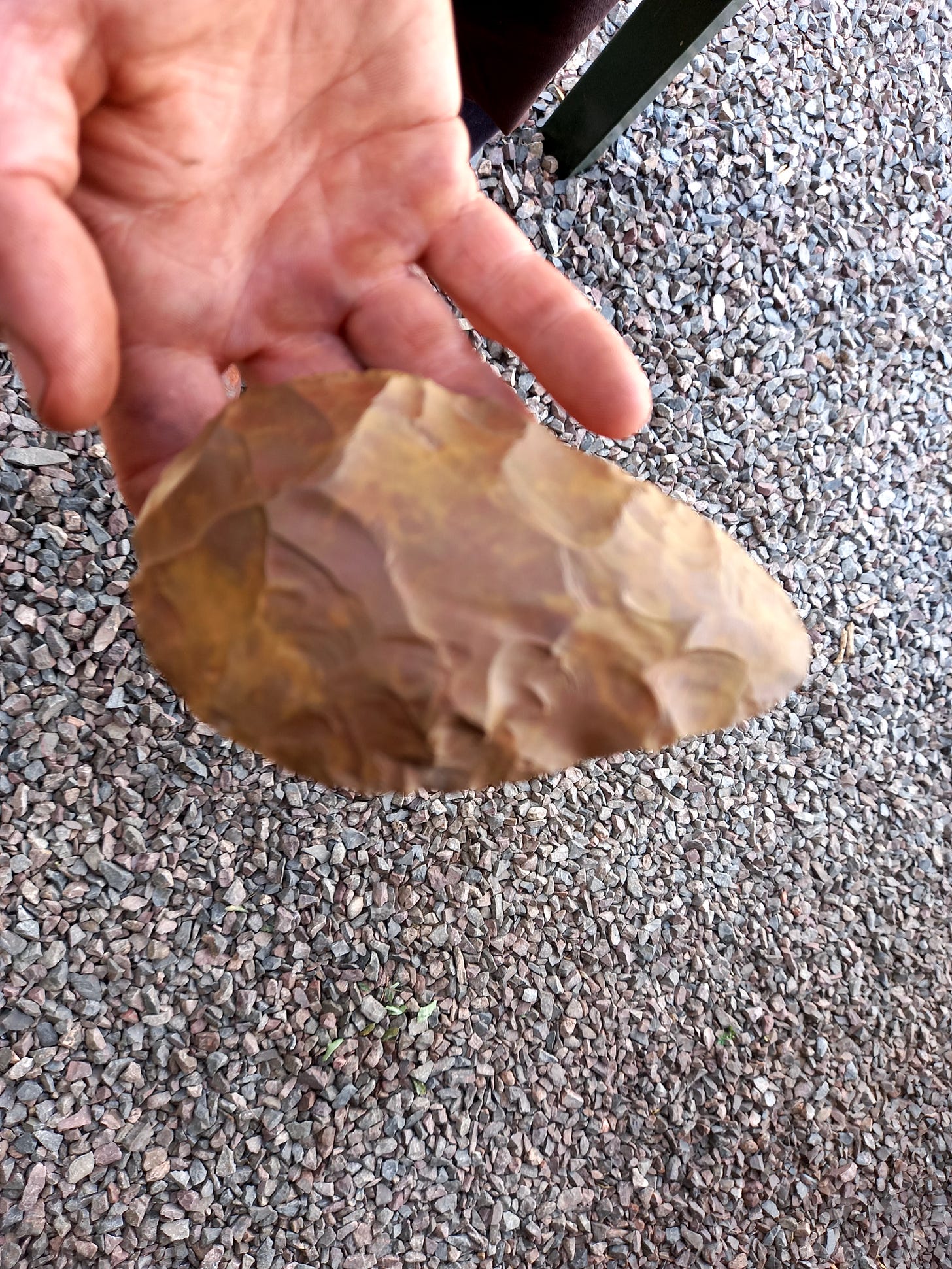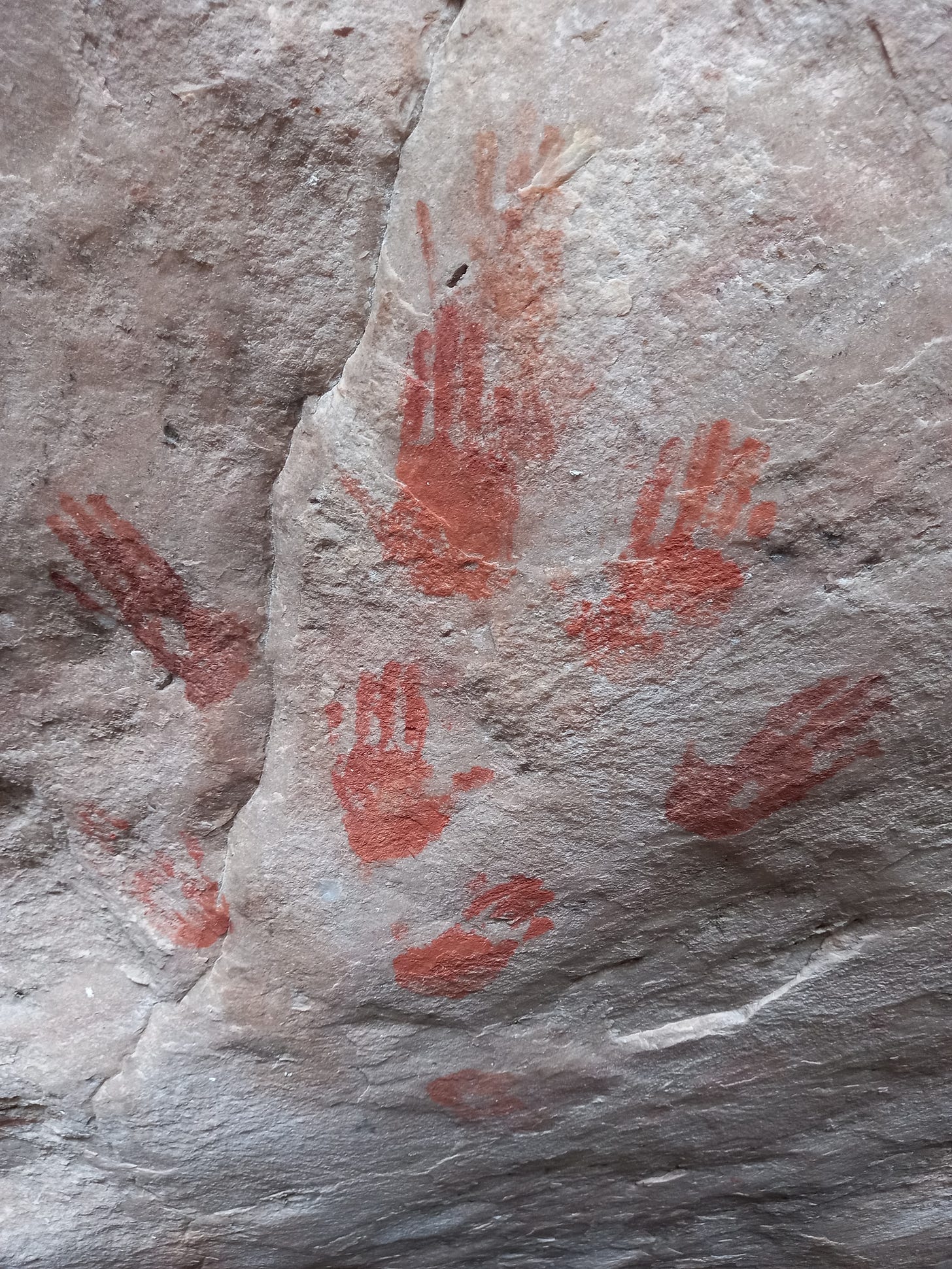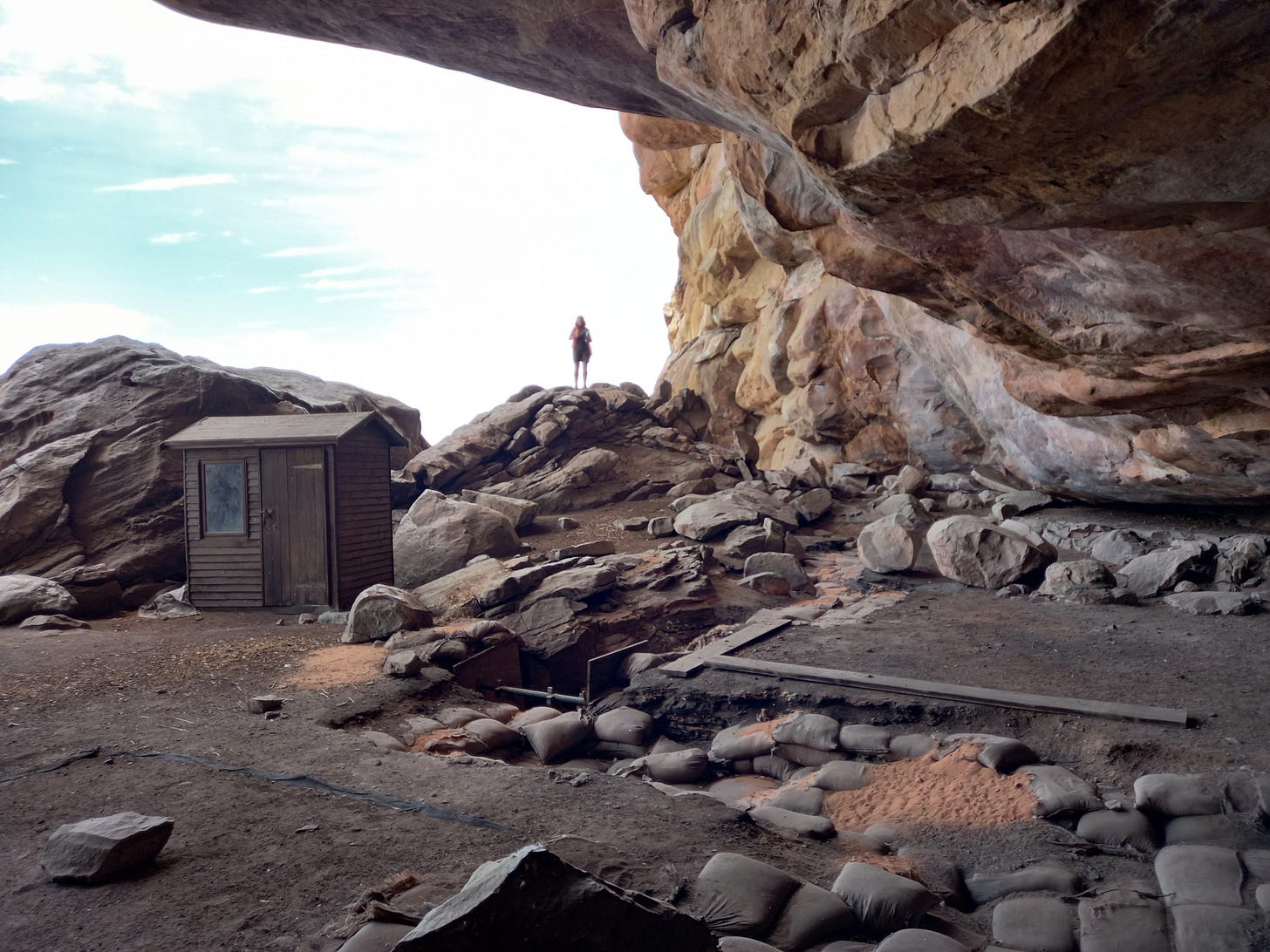New Frame, June, 2021
Level One Covid restrictions seemed to be a good time to go to places less visited, with a tent on board to be able camp outdoors, far from the risks and ravages of an unfriendly virus.
This would be a chance to explore places which I know of but have not visited, for instance the Wonderwerk Cave near Kuruman where the first controlled use of fire has been attested a million years back. There would also be a nearby cave, Blinkkopklip [Setswana: Tsantsabane], which has been mined for at least 1 200 years for an ore in its time seen as more precious than gold.
Also the Blombos cave on the southern Cape coast where people have been making art and jewellery for 70 000 years.
If you’re visiting caves, you’re also viewing the art done there. We’d also take in spaces sacred in times past, where chippings, scratches, engravings and paintings have left indelible messages from a forgotten past, transforming a timeless landscape into place but with meaning conceptualised in terms often obscure to us.
While much of this rock art is not of great antiquity itself, it is nonetheless a record which shows the activities of people and their tools, bows and arrows and digging sticks from stone age times. We see in this rock art the animals - eland, gemsbok, elephant and zebra - which have been on the scene so long it may as well have been forever.
The million-year time span is so vast that it considerably predates modern humans, homo sapiens, only having been around from about 250 000 to 200 000 years ago. But, as we were to see, the making of fire, tools and art stretches back much further than this. Our distant ancestors bristled with creativity as they shaped what we would become.
From settler times, there are images of sea-faring craft, men with hats with guns and women in long dresses, horses and wagons. Ours would be a humble journey in a small 4x4, but it would span three geological ages, the Pleistocene, the Holocene and the present Anthropocene, where man-made change hurtles us to a hellish future.
Wonderwerk
Wonderwerk, just off the main road between Kuruman and Danielskuil in the Kalahari, is a good place to start. While many sites billed as caves are often just large overhangs, Wonderwerk is a proper cave, three to seven metres high and extending 140 metres into the Kuruman hills.
The subject of detailed archaeological work since the 1970’s, Wonderwerk shows the earliest use of controlled fire, fragments of cooked animal and plant material being recovered and dated to a mind boggling one million years ago. This ancestor is usually identified as homo erectus, a hominin with just one-third the brain size of sapiens.
Wonderwerk cave, near Kuruman. Our ancestors made use of controlled fire here a million years ago. Photo: Kevin Davie
Mastery of fire is seen to have been a key technological achievement by early man, allowing for warmth, protection from predators, making food more palatable, nutritious and digestible, as well as extending activities earlier in the morning and later at night. Cooking, one view holds, transformed us from animal into human.
The area had obviously received good rains, long pale-green grass being in abundance. The cave, part of the Mcgregor Museum, looks outward across a sprawling plain where a little earlier we’d seen antelopes and ostriches. Guide Iris Khabae opened the small museum and then unlocked the heavy gate to the cave. Normally there’d be archaeologists on site, but Covid has halted work at present.
There is a long walkway down the middle to the back of the cave, the rest is all marked with string lines and tags, the deepest excavations being many metres deep, presumably to the one million year level.
Wonderwerk also claims to have been the longest occupation of any site, though only one family of occupants is known by name. This was the Bosman family who lived in the cave in the early 1900’s before building a farmhouse on the property. PE Bosman, a giant of a man, nearly two metres tall and weighing 200 kilograms, lived in the cave with his wife, 14 children and livestock.
Wonderwerk is best known for the oldest intended use of fire, but reading its archaeology I was interested to learn that specularite, an ore which when struck turns into liquid releasing an infinity of tiny sparkles, has been found at the level dating to 500 000 years ago.
Blinkkopklip
From following scientist explorer William Burchell’s 1812 route some years back I knew that specularite had been mined on the other side of the Kuruman Hills at a site called Blinkkopklip, not far from present-day Postmasburg. Archaeologists Anne Thackeray, JB Thackeray and Peter Beaumont reported in the early 1980’s that specularite had been mined there for at least 1 200 years.
Ian Watts, lead author of a 2016 paper which studied the use of specularite at three sites in the area, including Wonderwerk, said it, along with red ochre, had been in irregular use from 500 000 years ago and regular use from about 300 000 years. Pigment use, these authors say, is associated with fire-lit environments there being circumstantial evidence that the ores were transported over considerable distances.
They suggest that the back of the Wonderwerk cave - over 100 metres inside the hill - with its unusual sensory characteristics, was used for special ritual performance. “We speculate that it was used for fire-lit, body-painted, song-and-dance performances, the performers glittering and red,” says Watts.
Inside Wonderwerk, December 2020. Photo: Kevin Davie
Burchell said that the site was one of the most celebrated north of the Gariep [Orange] River, “being the only spot where sibilo [Setswana: specularite] is found. Hither all the surrounding nations repair for a supply of that ornamental and, in their eyes, valuable substance. It constitutes in some degree an article of barter with the more distant tribes, and even among themselves; so that it extends over at least five degrees of latitude [about 500 kilometres], or among every tribe I have visited.”
This appears to be confirmed in a South African Journal of Science article which reported in 1974 that buried ostrich egg shells containing specularite and possibly serving as caches had been found along the Orange, Vaal and Riet Rivers, locations 100 to 150 kilometres from Blinkkopklip.
Burchell did a drawing of the Shining Mountain as it is also called, which I sent ahead of the visit to “IJ” van der Linde, who lives nearby the koppie with her husband Ryan.
Entrance to ancient specularite mine at Blinkkopklip, enhanced by neat camera glare. Photo: Kevin Davie
Ryan said he had been into the cave when aged 11, but not since. He gave us directions. We were to look for a small hole, not much bigger than for an adult to fit in, at the base of the koppie. But extensive searching, while revealing some trenches and discards as evidence of mining, was not successful.
Ryan then took us along a more or less identifiable path lower down than where we’d been. After a short walk the ground was noticeably glisenning, covered with thousands of micro shiny particles. Around the corner was a cave. Inside, to the one side, was the man-sized hole, the access to the main chamber.
Ryan and I entered the cave, heading towards the hole. I immediately felt a wincing pain on my ear, and shortly afterwards, my shoulder. We were being attacked by wasps. “Run,” shouted Ryan as we quickly exited the cave. I had been more than keen to go into the cave proper, even though caving is not my thing, but these wasp sentinels, whose nests were arrayed strategically above us, meant that a bee keeping-type suit and head protection would be needed.
Just outside the cave was a bank of ore which looked like it was recently placed there by miners who had brought it out from the cavern. Ryan picked up some pieces and smashed them, releasing a soft watery liquid containing - seemingly and magically - its own sparkling micro universe.
Craig Foster, now of Netflix documentary My Octopus Teacher fame, described a visit to the cave in My heart stands in the hill, a book he co-authored with Janette Deacon in 2005:
“I had heard all these extraordinary stories about this elusive substance called //hara or specularite - stories of old shamans with their heads covered in this glistening material. Some people said that in old Africa it was more highly prized than gold or ivory. Yet, mysteriously, today, it wasn’t in use at all.”
Archaeologist Peter Beaumont told Foster about a cave he’d discovered many years before called Shining Mountain and drew a map on the back of an old cigarette carton. “Eventually we found a place called Shining Mountain (Blinkkopklip) and squeezed through a narrow gap into the cave. I looked back and the whole cave was raining //hara.”
We can learn more about //hara and its red ochre associate, tto from Hankasso, a /Xam man who had been imprisoned in the late 1800’s with others in Cape Town and who told his story to linguists Wilhelm Bleek and Lucy Lloyd, who spent more than a decade working out first how to write /Xam and then recording the stories of Hankasso and his former fellow prisoners.
Their Specimens of Bushman Folklore, 1911, says //hara (literally: mouth or opening) is both hard and soft. It quotes Hankasso: “//hara is black; the people [having mixed it with fat anoint their heads with it; while tto is red, and the people rub their bodies with it, when they have pounded it; they pound it, pound it, pound it, they rub their bodies with it. They pound //hara they anoint their heads . . .
“//hara sparkles; therefore, our heads shimmer, on account of it; while they feel that they sparkle, they shimmer. Therefore, the Bushmen are wont to say, when the old women are talking there: That man, he is a handsome young man . . . surpassingly beautiful with the //hara's blackness."
Hankasso told Lucy Lloyd that the tto mine is on the side of a mountain. “The people are afraid [of the sorcerers who live by the mine], because the people are aware that people are there (sorcerers). They (the sorcerers) make a house there.
“And when they go to the tto, they throw stones at the tto mine, when they wish the sorcerers to hide themselves, that they may go undisturbed to work at the tto, while they feel that the sorcerers dwell at the tto mine. Therefore, they take up stones, they throw stones at the tto mine, when they wish the sorcerers to hide themselves, that they may go in peace to collect tto.
They put away the //hara and the tto, and they return home.”
Burchell spent several months with the Tswana at Litakun, their settlement north-east of present-day Kuruman. Litakun was then equivalent in size to Cape Town. His intention was to stay long enough to learn Setswana. He did several portraits, showing sibilo in his subject’s hair, actually painting with specularite which he ground with “gum water or in oil”.
I asked Sabata Mokae, who writes in Setswana and teaches creative writing at the Sol Plaatje University, about sibilo. “Usually in Setswana when we become extravagant with language we refer to black people as ‘Bana ba mmala wa sebilo’ which means ‘children of the black lead’, he said.
“Usually Batswana would identify with minerals found where they lived. My people, Barolong, refer to one another as ‘Tshipi noto’ which means ‘iron ore’.”
Burchell said sibilo was mainly used on the head, the wearer considering himself properly adorned, and in full dress. “Indeed, to lay aside our European prejudices, it is quite as becoming as our own hair powder, and is a practice not more unreasonable than ours; with which it can in many respects be compared. There is, however, a real utility in it, or rather in the grease, for those who do not wear caps; it protects the head from the powerful, and perhaps dangerous, effects of a burning sun, as it equally does, from those of wet and cold.”
Deacon and Foster, though, came across the use of specularite which had deeper ritual significance than just sun protection. They tell in My heart stands in the hill of setting up camp near Brandvlei with a group of elders and then showing them samples of specularite and red ochre.
“The mood changed dramatically . . . It was as if we had opened a treasure chest of diamond jewellery. Ouma /Una was so excited with the specularite that she could scarcely contain herself and rushed off to her tent to apply some to her face.”
For many decades these elders had not seen specularite, which was used for face paint in the initiation ritual for girls known as “hokmeisie”, where older females painted the initiate’s face to resemble the markings of a gemsbok.
“Die gemsbok bul soek die vrouens (The gemsbok bull looks out for women),” Deacon and Foster were told.
Earlier Ryan had shown us a stone-age hand tool he had picked up on the dry river bed a week earlier across from his house. This is about 100 metres from the specularite cavern.
The tool, a hand axe in my inexpert view, was beautifully shaped. I took a photograph and sent it to David Morris, professor of archaeology at the Sol Plaatje University, a specialist in this area. His reply: “That's a lovely example of a handmade that could be at least 500 000 years old.”
Hand axe found near Blinkkopklip. Photo: Kevin Davie
I subsequently read that this form of tool fell out of use from about 300 000 years ago, by which time our ancestors have become much more sophisticated and more specialised in tool making.
We headed south, taking in a couple of rock art sites en route, a few days later coming across another stone-age tool while picking up keys to access a cave near Koekenaap, a few kilometres from Vredendal. Sited on a bend of the Olifants River, the cave has been somewhat transformed (“colonised”) to make it habitable for tourists, the imposed structures marring an otherwise magnificent shelter and site.
I sent a photo of this stone-age tool to Morris too, he replied that it was probably older than the first, our ancestors having made these tools from as long ago as 1,6-million years.
We made a stop at a overhang known as Heerenlogement (Gentlemen’s lodging) south of Klawer, where a hundred explorers in the colonial period, including scientists, missionaries and those in the employ of the colonial authorities, have since 1712 chiselled or written their names onto its walls. A spring at the base of the cave, and some protection from the elements appear to have been the main drawcards.
Visitors included flamboyant adventurer and ornithologist, François le Vaillant (1783), whose books on his southern African escapades enraptured readers across most of Europe, naturalist Carl Peter Thunberg (1774), Robert Gordon (1779), who led several parties into the interior and re-named the Gariep as the Orange River, missionary Robert Moffat (1817) and John Geddes Bain (1854), road building engineer and painter.
Besides the graffiti which is old enough to be legally protected, a tree, presumably the same described by Le Vaillant and James Alexander (1836), somehow grows in the tightest of cracks, most of the tree appearing to defy gravity up above you.
But as storied as Heerenlogement may be, we found it to be somewhat soulless, perhaps because it was not a destination in itself, but rather transient, a stepping stone to somewhere else.
Cederberg
Most of the art we’d seen so far, usually not in caves, were engravings cut into rock. This was to change as we moved into the coastal mountain ranges. The Cederberg mountains, in particular, with numerous caves, seem to be a continuous artscape, there are so many sites which include rock art, invariably not engraved but rather painted or drawn, the favoured pigment being the same used further north in conjunction with specularite, red ochre.
A mineral containing oxidised iron, ochre doesn’t wash away or decay easily, it adheres to surfaces when applied, including the human body. On rock, over time it stains and becomes part of the surface.
The Cederberg art has been extensively surveyed, including in numerous books, there being reckoned to be over 2 000 paintings in the area, much of which is off the beaten track and can be hard to find. While this can help protect the paintings, protection and preservation remaining an issue. Interpretation can also be difficult but tours and guide books are available.
A recent innovation, which meets some of these challenges, is virtual 3D tours with expert commentary by UCT archaeologist John Parkington who explains a scene from the Procession Cave at Warmhoek (https://www.virtualtours.ctsheritage.com/warmhoek/) which shows a procession of figures, some cloaked, some naked, following two eland.
Those cloaked, wearing an eland skin known as a kaross, have in this worldview assumed the life of the animal: the wearing of the skin makes them an eland.
The karossed figures, their weapons in hunting bags, have concluded the first-kill ritual where a sizable animal such as an eland, kudu or gemsbok, is killed. Parkington says that the uncloaked figures, also male, have bows and arrows ready to make their first killing which will constitute a re-birth, the young hunter is virtually re-born as a man and is allowed to marry.
Hunting divides men from women, he says. In the Kalahari, men are said to hunt women. A girl is said to have shot an eland when she first menstruates, she then being secluded with older women who perform the eland bull dance to welcome her into the herd. She may now, in a virtual sense, be hunted and eaten by young men who have also - more literally - shot their own eland.
We camped near Elands Bay on the Verlorenvlei, in times past the Quaecoma River, now a 20-kilometre stretch of reeded water where flamingos feast on its muddy shores. There are two caves here, Diepkloof and the Elands Bay cave, the latter, which overlooks the mighty ocean which visits the shores below, has been occupied on and off from over 40 000 years to 300 years ago. Dots, hands and human figures are drawn in red ochre on its walls.
Diepkloof hands. Photo: Kevin Davie
Diepkloof, at the top end of the vlei, stands high in its surrounds, there being something of a climb to get to it. There are two caves, really, one a little lower than the second where the evidence of archaeological digging is present. Both caves have drawings in red ochre, mostly of hands, but also dots (in black and red) and some human figures and animals.
Decorated ostrich shells found at Diepkloof date back to between 55 000 and 65 000 years. Photo: Kevin Davie
Red ochre use at Diepkloof dates back 110 000 years. Tammy Hodgkiss, curator of the Origins Centre at Wits University, who has studied red ochre use, says 558 pieces of ochre and a grindstone dated to between 110 000 and 52 000 years ago, have been found.
Also found at Diepkloof are 400 decorated ostrich shell fragments dated to between 55 000 and 65 000 years ago.
The use of red ochre over an extended period at Diepkloof is by no means unusual. Archaeological studies at a set of southern African caves show a similar picture, there being only two recurrent items retrieved at these sites, some of which date back as far as 300 000 years, stone tools and red ochre.
In cases red ochre was harvested at seemingly industrial scale, at least for the times, a case in point being Lion Cavern in eSwatini, at 43 000 years the world’s oldest mine and where thousands of tons of ore were removed.
But if there’s a stand-out cave in this story, which was also on our itinerary, it's Blombos on the south-western Cape. Over 8 000 pieces of ochre have been found here at levels dating between 100 000 and 70 000 years ago. These include ochre-processing toolkits, abalone shells being used for mixing and storing ochre.
A particularly famous Blombos find, by University of the Witwatersrand archaeologist Christopher Henshilwood, is a single piece of ochre, dated to 75 000 years ago, marked with a set of geometric shapes, the earliest evidence of apparently engraved or drawn art.
I was well aware that this is widely cited as the earliest example of art, but had not realised that the work is actually a design on a large piece of red ochre, usually described by archaeologists as a crayon. Our oldest art is an engraving on a tool for making art.
Shells with perforated holes to make a necklace, containing traces of red ochre and dated to the same period, have also been found at Blombos. The markings on ochre crayons and ostrich shells have no clear meaning to us, Hodgkiss writing that scholars “can be confident that the engravings represent novel behaviour and indicate some of the earliest evidence of the storage of information outside of the brain”.
Hodgkiss analysed 9 000 pieces of ochre, dating from 77 000 years ago to 37 000 which were recovered at Sibudu Cave, north of Durban in KwaZulu Natal, to understand the cognitive abilities required by ochre users.
She found that both simple and complex cognitive abilities were required, the latter suggesting the people living there had advanced mental capabilities like modern humans living today. “Ochre use can be employed as a proxy for cognitive capabilities, and can therefore shed light on the evolution of the modern mind,” she says.
Ian Watts, who has reviewed the evidence for the use of red ochre at a set of southern African cave sites, says he knows no hunter-gatherer society without some form of body marking - predominantly body painting, but including tattooing and scarification. He says that whereas language leaves no material trace, the use of red ochre as a manifestation of collective ritual may contribute to both our understanding of the evolution of language and our emergence as a species.
Our species evolved in Africa sometime between 150 000 and 200 000 years ago, Watts says, adding that the cultural tradition of red ochre use indicates that symbolic traditions were present in Africa by the time a small subgroup of homo sapiens migrated beyond the continent about 80 000 to 60 000 years ago.
Watts draws on French sociologist Emile Durkheim, who, based on his observations of aboriginal Australians, proposed that the first form of art consisted of geometric designs painted in red ochre, which symbolosed blood on sacred objects and on the bodies of ritual performers.
Durkheim, the first to posit a link between language and ritual, argued that collective emblems had to be abstract because the representations concern social facts - things that have no real-world likenesses but exist only by virtue of collective agreements.
The use of ochre as a body covering and adornment has continued until recent times. In the case of the Himba, who live in northern Namibia, it continues at present.
A million-year journey
Our plan had been to visit Blombos and other caves. President Cyril Ramaphosa’s announcement of renewed Covid restrictions on December 28, 2020 with an instruction to restrict all but essential travel, meant that we pointed our little 4x4 for home.
We stopped at Driekops Eiland, near Douglas, en route. The site has 3 500, mostly geometric motifs engraved on large slabs of striated rock, smoothed by glaciation in the deep past. The slabs are the bed of the Riet River [previously ‘Gumaap, !Kora for Muddy River], the motifs being underwater depending on the level of the river.
They have been much studied and analysed, all manner of speculation on their meaning being advanced, including that they are the work of aliens. Some academics see them to be entoptic phenomena produced naturally by the brain while in trance.
Hankasso had a simpler explanation. Shown a set of similar symbols to those of Driekops, from a site also of striated rocks near Pniel on the Gy Gariep (Vaal) River), he told Lucy Lloyd that dots are “those which resemble what people are wont to do to our heads with tto. They put dots (with the forefinger of the right hand) on our heads . . . our heads resemble the hunting leopard, they have spots,” he said, as quoted by Pippa Skotnes in Unconquerable spirit: George Stow’s history paintings of the San, 2008.
Skotnes notes that one motif engraved on the rocks is a lattice of squares, Hankasso telling Lloyd that these show a mat sieve used by Bushmen women to sift Bushman rice [ant larvae].
David Morris has written that the engravings are the residue of a ritual sequence; there being strong links between the water snake and female puberty in the oral histories of a large number of Northern Karoo cultural groups. In Nama [a Khoikhoi language] the same root-word is used for blood, snake, rain, the colour red, and waterhole, he writes.
I asked him if these rituals are still practised in the area. He knows of recorded cases from around 1990, including one in the Richtersveld which he observed. This was where older women re-enacted the puberty ritual, painting a geometric pattern on the face of one of the women.
He added that if still practised the first-menstruation ritual would be below the radar as the rituals do not fit Christian beliefs now dominant in the region.
I knew in advance of this journey that we’d be visiting sites of great antiquity and that red ochre has been in use for some time. That this use extends perhaps to before our speciation and contributed to it, came as a major surprise. We see art as something external to ourselves, not contributing to what we became.
We see too, though, in this art the period since settler occupation, a galleon and other sea-faring craft, sheep, horses, cattle, wagons, women in long dresses and men with guns. And, from the industrial age, a speeding train.
And this was my biggest takeaway from the trip. It took an eon to get from the controlled use of fire a million years ago to where we are now. Since industrialisation took hold two centuries ago, we now, according to the United Nations’s International Panel on Climate Change (IPCC), have fewer than ten years left to reign in the worst effects of climate breakdown if we want to have a habitable planet.

